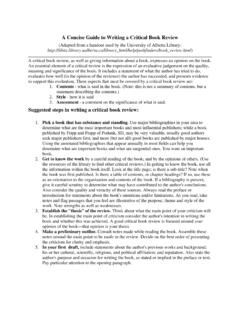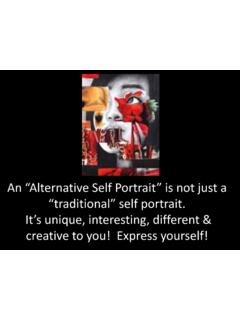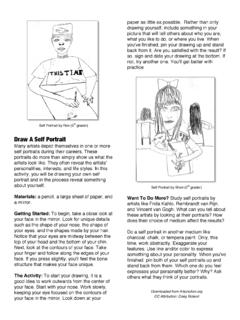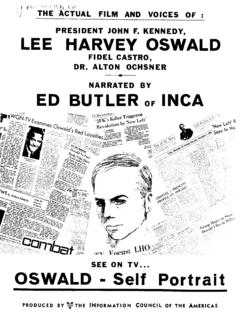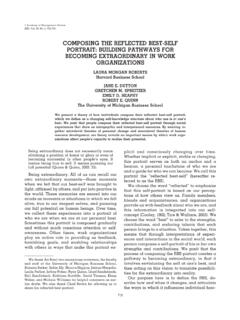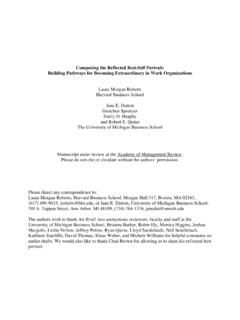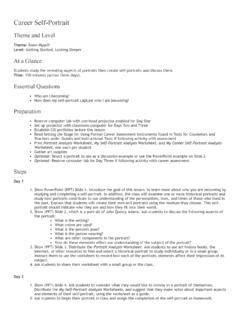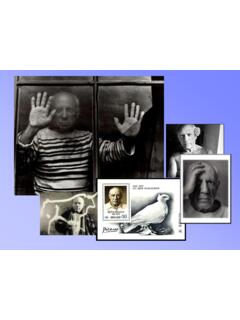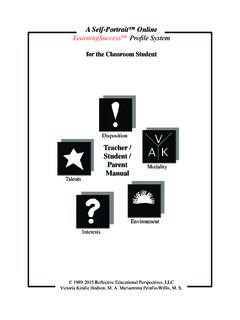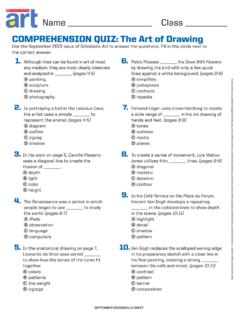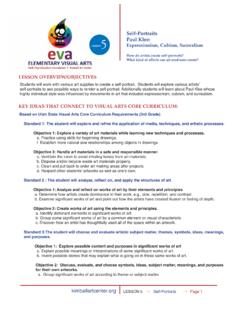Transcription of The “Eternal Return”: Self‐Portrait Photography as a ...
1 The Eternal Return : self portrait Photography as a Technology of EmbodimentAuthor(s): Amelia JonesSource: Signs, Vol. 27, No. 4 (Summer 2002), pp. 947-978 Published by: The University of Chicago PressStable URL: .Accessed: 01/04/2014 11:12 Your use of the JSTOR archive indicates your acceptance of the Terms & Conditions of Use, available at ..JSTOR is a not-for-profit service that helps scholars, researchers, and students discover, use, and build upon a wide range ofcontent in a trusted digital archive. We use information technology and tools to increase productivity and facilitate new formsof scholarship. For more information about JSTOR, please contact .The University of Chicago Press is collaborating with JSTOR to digitize, preserve and extend access to This content downloaded from on Tue, 1 Apr 2014 11:12:48 AMAll use subject to JSTOR Terms and Conditions[Signs: Journal of Women in Culture and Society2002, vol. 27, no.]
2 4] 2002 by The University of Chicago. All rights reserved. 0097-9740/2002/2704-0008$ JonesThe Eternal Return : self - portrait Photography as aTechnology of EmbodimentThe subject has no relation to him[/her] self that is not forced to deferitself by passing through the other in the form .. of the eternalreturn. Jacques Derrida (1982) 1985, 88 Awoman, fleshy, middle-aged,is luxuriating in a bed of animal fur andlush tropical plants. Moist, lipsticked lips barely parted, eyelids softlyclosed, the naked flesh of her chest (cut off by the edge of the frame)is covered with an odd talisman (animal bone or shell?) and perhaps acat, who seems to be stretching its paw up across her chest to her is vibrantly alive, though somnolent, dreamy, erotically quiet..She is dead to the Cahun, in this remarkable self - portrait (Autoportrait, c. 1939)(fig. 1), presents herself to us in a manner that transforms, at once, theconception of the self - portrait and the very notion of the subject.
3 It issuch moments of photographic self -performance, emerging sporadicallyin Victorian and modernist Photography (think of the Countess de Cas-tiglione, Adolph de Meyer, Florence Henri, and Cahun) and then, inThis essay was initially delivered at the Performative Sites conference at PennsylvaniaState University in October 2000; I am grateful to Charles Garoian and Yvonne Gaudeliusfor the opportunity to participate in that conference and to deliver my essay in tandem withPeggy Phelan, whose work so clearly informs this project. Sections of this essay have alsoappeared in earlier forms supporting related arguments in the following texts: Posing theSubject/Performing the Other as self (2000) and Performing the Other as self : CindySherman and Laura Aguilar Pose the Subject (in press). Finally, I am very grateful to theUniversity of California, Riverside, for a sabbatical leave, which was instrumental to thecompletion of this essay, and to my colleagues and students there for ongoing to Meiling Cheng, Peggy Phelan, and John Welchman for comments and suggestionsthat vastly improved this essay and to the anonymousSignsreaders for questioning my ownmode of self -performance, asking me to look more closely at some of the parameters of content downloaded from on Tue, 1 Apr 2014 11:12:48 AMAll use subject to JSTOR Terms and Conditions948 JonesFigure 1 Claude Cahun,Autoportrait( self - portrait ) (c.)
4 1939). Black-and-white photo-graph, 3 3/16#3 7/8 inches. Jersey Heritage Trust, United , in postmodern photographic practice (Andy Warhol, Yayoi Kusama,and beyond), which establish an exaggerated mode of performative self -imaging that opens up an entirely new way of thinking about photographyand the racially, sexually, and gender-identified subject. (And, surely, it isno accident that the practitioners of such dramatically self -performed im-ages are all women, not aligned with whiteness, and/or oth-erwise queer-identified in some way;1 Cahun was a lesbian.)These performative images are still self -portraits in the sense thatthey convey to the viewer the very subject who was responsible for stagingthe image (though, as in the case of the Countess de Castiglione or1 Byqueer-identifiedI mean that they functioned outside the norms of sexual subjectivityestablished in the culture at large and, in particular, in art discourse.
5 While the art world isin one sense a haven for queers a kind of discursive and sometimes institutional Bohe-mia it is also, as many have pointed out, a deeply sexist, racist, and heterosexist site thatdemands, for public consumption at least, that its geniuses be straight, white, and the impact of the rights movements in the 1960s and beyond, this, of course, haschanged in some ways, but lingering effects remain deeply embedded. See Jennifer Brody sbrilliant ruminations about the veiled bigotry in the art world in Fear and Loathing in NewYork: An Impolite Anecdote about the Interface of Homophobia and Misogyny (in press).This content downloaded from on Tue, 1 Apr 2014 11:12:48 AMAll use subject to JSTOR Terms and ConditionsS I G N SSummer 2002 949 Kusama, not always for actually taking the picture),2and yet throughtheir very exaggeration of the performative dimension of the self (itsopenness to otherness and, especially clearly in representation, its contin-gency on the one who views or engages with it) clearly they profoundlyshift our conception of what a self -portraitis.
6 The point of this essay isto engage with such images in particular, the more contemporary workof Cindy Sherman, Hannah Wilke, Lyle Ashton Harris, and LauraAguilar in such a way as to open out the question of how subjectivityis established and how meaning is made in relation toallrepresentationsof the human body. In her poignant and incisive bookMourning Sex,Peggy Phelan cuts into the heart of what I am concerned with in thisessay, writing of the deep relationship between bodies and holes, andbetween performance and the phantasmatical (1997, 3).I propose here to make use of these works that draw on strategiesestablished by artists such as Cahun in order to flesh out Phelan s idea,which gets at the core of how the subject relates to and is establishedvia structure of exaggerated self -performance setup in the works I discuss here points to the profound duality of thephotographic representation of the body.
7 In these works, the subject per-forms herself or himself within the purview of an apparatus of perspectivallooking that freezes the bodyasrepresentation and so as absence, asalways already dead in intimate relation to lack and loss. The photograph,after all, is a death-dealing apparatus in its capacity to fetishize and congealtime. At the same time, in their exaggerated theatricality, these worksforeground the fact that the self - portrait photograph is eminently per-formative and so life giving. As Phelan s model suggests, this duality isnot resolvable in either direction; the two poles activated in the repre-sentation of the human body inevitably coexist (thus she points, as wehave seen, to the deep relationship between bodies and holes ).2 For a brilliant discussion of the images of the countess, nominally taken by the nine-teenth-century Parisian firm Mayer & Pierson but clearly choreographed by the countessherself, see Solomon-Godeau s argument is applied to representation in general, and some of her examplesare paintings.
8 However, Phelan s exploration of the relationship between representations ofbodies and what Maurice Merleau-Ponty would call theflesh of the world, between the surfaceof images and the profound holes and depths of bodies, is highly compelling as appliedto the exaggerated case of performative photographic self -portraits. Phelan s model allowsus to go beyond postmodern arguments that pose reiterative, theatrical representations ofbodies as simply false or simulated (arguments that have dominated the discussion of Sher-man s works), offering a way of understanding the deep, chiasmic links between represen-tations of bodies and fleshed content downloaded from on Tue, 1 Apr 2014 11:12:48 AMAll use subject to JSTOR Terms and Conditions950 JonesExaggerating their own performances of themselves, these artists, then,explore the capacity of the self - portrait photograph to foreground the I as other to itself, the artistic subject as taking place in the future throughinterpretive acts that bring her or him back to life via memory and desire(the I, I am arguing, isalwaysother to itself; these practices merelyforeground this structure of subjectification).
9 4 This exploration of theprocess by which we constitute ourselves in relation to others pivots forthese artists around the mobilization of technologies of representation:by performing the self through photographic means, artists like Cahunplay out the instabilities of human existence and identity in a highly tech-nologized and rapidly changing environment. The self - portrait photo-graph, then, becomes a kind oftechnology of embodiment, and yet onethat paradoxically points to our tenuousness and incoherence as living,embodied this argument will foreground the fact that, as KatherineHayles has recently put it, the overlay between .. enacted and rep-resented bodies is .. a contingent production, mediated by a technologythat has become so entwined with the production of identity that it canno longer meaningfully be separated from the human subject (1999,xiii). The self - portrait photograph is an example, if relatively low tech compared to the flashy interactivities engendered by video installationsand Web art, of this way in which technology not onlymediatesbutproducessubjectivities in the contemporary world.
10 By using these exag-gerated examples of theatrical, photographic self -production, I hope toexplore how all images work reciprocally (though surely in different waysand to different degrees) to construct bodies and selves across the inter-pretive bridges that connect argument will draw on several well-known theoretical con-structs the screen, the fetish, the gaze, reiteration, the pose, thepunc-tum, the chiasm each of which will highlight a different aspect of thereciprocal engagement that establishes us in relation to such images. Ul-timately, as Phelan and Hayles suggest, such a query casts us back into4 This is not at all the same as saying that the photograph somehow immortalizes thesubject of the portrait but rather, as I discuss at greater length below, that the photographreiterates the subject (restates her or him such that she/he can be engaged by future inter-preters) in some sense beyond the moment of the picture s taking and, potentially, after thesubject s literal death.

